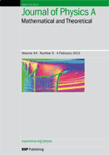
Journal of Physics A-Mathematical and Theoretical
Scope & Guideline
Fostering Collaboration in Cutting-Edge Physics Research
Introduction
Aims and Scopes
- Mathematical Physics:
The journal emphasizes mathematical formulations and techniques that underpin physical theories, ranging from quantum mechanics to statistical mechanics and field theories. - Quantum Information and Computation:
Recent publications highlight the intersection of quantum mechanics with information theory, exploring quantum algorithms, entanglement, and quantum communication. - Statistical Mechanics and Thermodynamics:
A consistent focus on the statistical mechanics of complex systems, including phase transitions, critical phenomena, and thermodynamic limits. - Integrable Systems:
Research on integrable models, soliton solutions, and their applications in various physical contexts is a key area, reflecting the journal's commitment to mathematical rigor. - Field Theory and String Theory:
The journal publishes works related to quantum field theories, string theory, and their mathematical structures, contributing to foundational aspects of theoretical physics. - Nonlinear Dynamics and Chaos:
An exploration of chaotic systems, including stochastic processes and their implications for understanding complex behaviors in physical systems. - Topological and Geometric Aspects:
Research exploring topological phases, geometric quantum theories, and their implications in modern physics is gaining prominence in the journal.
Trending and Emerging
- Quantum Technologies:
There is a growing interest in quantum technologies, including quantum computing, quantum cryptography, and quantum simulations, as researchers explore practical applications of quantum mechanics. - Machine Learning and Data Science in Physics:
The integration of machine learning techniques into physics research is becoming increasingly prevalent, with studies focusing on data-driven approaches to solve complex physical problems. - Complex Systems and Networks:
Research on complex systems, particularly in the context of network theory and dynamics, is gaining traction, reflecting the interdisciplinary nature of modern physics. - Non-Hermitian Quantum Mechanics:
An emerging focus on non-Hermitian systems and their implications for quantum mechanics showcases the journal's commitment to exploring unconventional frameworks. - Entanglement and Quantum Correlations:
Interest in entanglement measures, quantum correlations, and their applications in quantum information and thermodynamics is rising, highlighting the relevance of these concepts in current research. - Mathematical Foundations of Quantum Theory:
A resurgence in the exploration of the mathematical foundations of quantum mechanics, including topics like contextuality and non-locality, is evident in the recent literature.
Declining or Waning
- Classical Mechanics:
There is a noticeable reduction in classical mechanics topics, particularly those unrelated to modern theoretical advancements, as the focus shifts towards more quantum and statistical approaches. - Low-Dimensional Systems:
Research on low-dimensional systems, such as one-dimensional lattice models, appears to be waning, potentially due to the increasing complexity and interdisciplinary nature of current research. - Experimental Physics Correlations:
The journal's articles have increasingly emphasized mathematical and theoretical frameworks over experimental correlations, which may reflect a broader trend in theoretical physics. - Linear Quantum Theories:
Linear approaches to quantum mechanics are being overshadowed by studies focusing on nonlinear dynamics and complex systems, indicating a shift in research priorities.
Similar Journals
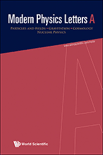
MODERN PHYSICS LETTERS A
Pioneering Discoveries in Modern PhysicsMODERN PHYSICS LETTERS A, published by World Scientific Publishing Co Pte Ltd, is a distinguished journal in the field of physics that serves as a pivotal platform for researchers, professionals, and students alike. With ISSN 0217-7323 and E-ISSN 1793-6632, the journal has gained international acclaim for its contributions to Astronomy and Astrophysics as well as Nuclear and High Energy Physics. The journal is ranked in Q3 for both Astronomy and Astrophysics and Nuclear and High Energy Physics, showcasing its relevance in these areas, while also achieving a Q2 ranking in the broader category of Physics and Astronomy (miscellaneous). Spanning from 1996 to 2024, MODERN PHYSICS LETTERS A promotes open dialogue and dissemination of pioneering research findings and innovative theories. While the journal operates without an open access option, its rich content is easily accessible through various academic databases, ensuring that vital research is shared widely among the scientific community. Situated in Singapore, this journal plays an essential role in the continuous advancement of the physics discipline, fostering collaboration and knowledge sharing among global researchers.
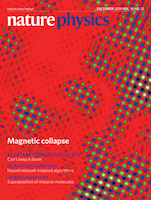
Nature Physics
Connecting Ideas, Inspiring Innovation in PhysicsNature Physics is a premier journal dedicated to publishing high-impact research in the realm of physics, brought to you by the esteemed NATURE PORTFOLIO. With its ISSN 1745-2473 and E-ISSN 1745-2481, this journal has established itself as a vital resource for the physics community, enjoying a remarkable Q1 quartile ranking in the Physics and Astronomy category for 2023 and securing an impressive Rank #5/243 and a 98th percentile ranking in Scopus. Since its inception in 2005, Nature Physics has become a catalyst for innovation, featuring cutting-edge research that encompasses a broad spectrum of physics disciplines. Although it operates under traditional subscription models, it maintains a commitment to accessibility through selective publications and editorial excellence. Positioned in Berlin, Germany, this journal is a must-read for researchers, professionals, and students who seek to stay at the forefront of advancements in physics.
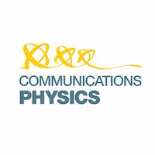
Communications Physics
Advancing the frontiers of Physics and Astronomy.Communications Physics is a premier open access journal published by Nature Portfolio, dedicated to disseminating high-quality research in the field of Physics and Astronomy. Since its inception in 2018, the journal has rapidly established itself as a vital platform for innovative scientific communication, boasting an impressive Impact Factor and achieving Q1 status in the 2023 category of Physics and Astronomy (miscellaneous). With a Scopus rank of #31 out of 243, placing it within the 87th percentile, Communications Physics attracts a global audience of researchers, professionals, and students eager to engage with cutting-edge findings. The journal supports open access, ensuring that research is freely available to the public, which enhances its visibility and encourages broader discussions within the scientific community. Located in Berlin, Germany, Communications Physics aims to bridge the gap between various disciplines within physics, fostering interdisciplinary collaboration and inspiring future research endeavors.

INTERNATIONAL JOURNAL OF THEORETICAL PHYSICS
Exploring the Frontiers of Theoretical PhysicsInternational Journal of Theoretical Physics is a premier academic journal dedicated to the advancement of knowledge in the fields of theoretical physics and mathematics. Published by Springer/Plenum Publishers, this esteemed journal has been a vital platform for researchers since its inception in 1968. With an impressive track record and an emphasis on high-quality, innovative research, the journal currently ranks in the third quartile (Q3) in both the Mathematics (Miscellaneous) and Physics and Astronomy (Miscellaneous) categories as of 2023. While the journal is not open access, it offers accessible subscription options for institutions and individuals. The International Journal of Theoretical Physics serves as an essential resource for scholars and practitioners looking to deepen their understanding and contribute to the evolving landscape of theoretical research, making it a key player in nurturing academic discourse and fostering collaboration in its field.

Symmetry Integrability and Geometry-Methods and Applications
Transforming Complex Concepts into Accessible InsightsSymmetry Integrability and Geometry-Methods and Applications is a prominent open-access journal published by the NATIONAL ACADEMY OF SCIENCES OF UKRAINE, INSTITUTE OF MATHEMATICS, dedicated to advancing research in the fields of Analysis, Geometry and Topology, and Mathematical Physics. Since its inception in 2005, the journal has provided an esteemed platform for scholars from around the globe to share their innovative findings and methodologies, contributing to our understanding of complex mathematical concepts. With an impressive Q2 ranking in all three mathematical categories as per the 2023 Scopus rankings, the journal positions itself as a key resource for researchers seeking high-quality, peer-reviewed content. As a fully open-access publication, it ensures that research is readily available to a wide audience, fostering collaboration and knowledge exchange in the mathematical sciences.

COMMUNICATIONS IN MATHEMATICAL PHYSICS
Connecting Ideas, Inspiring DiscoveriesCOMMUNICATIONS IN MATHEMATICAL PHYSICS is a premier journal in the realm of mathematical physics, published by Springer and recognized for its rigorous scholarship and comprehensive coverage of the field since its inception in 1965. With an impressive impact factor reflecting its influential contributions—ranking Q1 in both Mathematical Physics and Statistical and Nonlinear Physics—the journal consistently attracts high-quality submissions. It holds notable standings in Scopus, ranked 11th in Mathematical Physics and 12th in Statistical and Nonlinear Physics, marking it as a critical venue for both emerging and established researchers. The journal is dedicated to the dissemination of groundbreaking research and reviews, thereby fostering dialogue and innovation in a constantly evolving discipline. It provides invaluable access to cutting-edge theoretical advancements, making it an essential resource for professionals and students alike engaged in this dynamic field of study.

Annales de l Institut Henri Poincare D
Pioneering Research in Algebra and GeometryAnnales de l Institut Henri Poincare D, published by the esteemed EUROPEAN MATHEMATICAL SOCIETY, is a notable open-access journal dedicated to advancing the fields of mathematics and physics. With an ISSN of 2308-5827 and E-ISSN 2308-5835, this journal has risen to prominence since its inception in 2014, benefiting from a significant level of accessibility since 2022. Based in Germany, it provides a rigorous platform for scholarly research in areas such as Algebra and Number Theory, Discrete Mathematics and Combinatorics, Geometry and Topology, Statistical and Nonlinear Physics, and Statistics and Probability, where it has achieved a Q1 quartile ranking in 2023. With its Scopus ranking reflecting excellent percentile standings, particularly in Algebra and Geometry, Annales de l Institut Henri Poincare D is essential reading for researchers and academics seeking to engage with cutting-edge developments and innovative methodologies in their respective fields. Researchers can find it valuable not only for its high-quality publications but also for its commitment to fostering a global knowledge exchange in mathematics and physics.
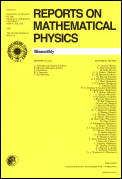
REPORTS ON MATHEMATICAL PHYSICS
Illuminating the Foundations of Physical PhenomenaREPORTS ON MATHEMATICAL PHYSICS is a distinguished journal published by PERGAMON-ELSEVIER SCIENCE LTD, focusing on the intricate interplay between mathematics and physics. Established in the United Kingdom, this journal has been contributing to the academic community since its inception, publishing significant research findings that explore the theoretical underpinnings of physical phenomena. With an ISSN of 0034-4877 and an E-ISSN of 1879-0674, the journal maintains a consistent publishing history, converging research from 1970 to 2024. It is currently ranked Q3 in both Mathematical Physics and Statistical and Nonlinear Physics categories, reflecting its commitment to maintaining a high standard of scholarly work. Although it lacks Open Access options, its targeted audience of researchers, professionals, and students will find invaluable insights into advanced mathematical methods, statistical applications, and innovative approaches in physics. With its esteemed reputation and critical role in the field, REPORTS ON MATHEMATICAL PHYSICS continues to be an essential resource for those seeking to deepen their understanding of mathematical applications in physical systems.

ANNALES HENRI POINCARE
Shaping the Future of Physics with Peer-Reviewed ExcellenceANNALES HENRI POINCARE is a prestigious journal published by Springer International Publishing AG, dedicated to advancing research in the fields of Mathematical Physics, Nuclear and High Energy Physics, and Statistical and Nonlinear Physics. With an impressive Q1 ranking in its respective categories as of 2023, this journal is recognized as a vital resource for academic researchers, professionals, and students engaged in frontier studies of theoretical and applied physics. The journal's commitment to high-quality peer-reviewed articles promotes significant contributions to the understanding of complex physical phenomena, making it essential reading for anyone seeking to stay abreast of developments in these dynamic fields. Additionally, ANNALES HENRI POINCARE offers open access options to enhance the visibility and accessibility of groundbreaking research, underscoring its role in fostering collaborative scientific inquiry and innovation. Since its inception in 2000, it has continually provided a platform for scholars worldwide to disseminate their findings and engage with the broader scientific community, thus establishing itself as a cornerstone of academic literature.

Physics
Empowering Research: A Platform for Physics ExcellencePhysics, published by MDPI, is an open-access journal that commenced in 2019 and has quickly established itself as a significant contributor to the field of physics and astronomy. With a respectable impact factor and categorized in the Q2 quartile for 2023, this journal serves a broad spectrum of topics within the discipline, fostering innovative research and insights. As part of the MDPI portfolio, known for promoting high-quality, peer-reviewed research, Physics aims to provide a platform for scholars, professionals, and students to publish their findings and engage with contemporary debates in the field. The journal's accessibility, paired with its commitment to scientific excellence, ensures that research is readily available to a global audience, which is crucial for advancing knowledge and collaboration in physics. Located in the heart of Switzerland at ST ALBAN-ANLAGE 66, CH-4052 BASEL, the journal enjoys a position at the nexus of cutting-edge research and academia.